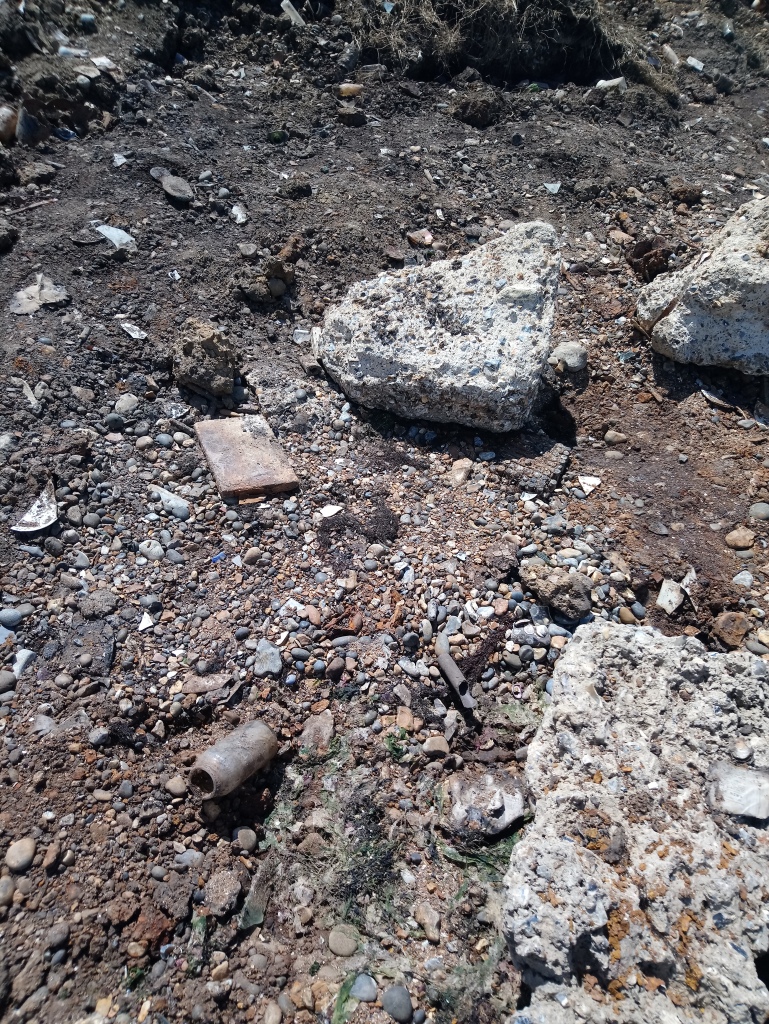
Don’t Listen Up is a collaborative work by artists Magz Hall and Peter Coyte. Who are concerned with air and sea pollution across east Kent where they live, unveiling the garden of England’s dirty secrets, via field, radio and hydrophone recordings.
Magz Hall and Peter Coyte teamed up to make an auditory work which maps and makes audible sea and air pollution. Mixing live real time flight communication across the Thames Estuary and Medway, the pathway of five major flight paths. The piece transmits live air traffic and hydrophone recordings of the polluted sewage ridden sea and mixes field recordings from Shelford commercial landfill site in Canterbury which has been leaking methane gas and pollution into the air, and electrical pylon pollution recorded during a public sound walk around the site.
“Electrical pollution swarms like bees”
“Stinking diesel pump, dredges the green lake water onto crops”
“Deadly methane hisses out as it leaks from a pipe into the air stream”
The work takes the listener to a woodland walk on the edge of Canterbury where nature is drowned out by the humming electric pylons which vibrate through the woods like killer bees. Dumped plastic strawberry pallets litter the fields under these imposing electric towers whose wires stretch over the woodland leading to a former fishing lake cleared by an ear-splitting diesel pump which deafens the air and dulls the senses and throat, sucking away the green stagnant water to divert it on to crops. Across the meadowland a silent threat floats in the air, hissing methane gas seeps out of pipes at Shelford landfill where commercial waste is harvested for power just a few hundred meters from homes. The AM flight transmissions of a major fight paths across Kent, from Europe to the capital, take us a few miles away to the coastal underwater waste pipe at Tankerton where sewage is regularly pumped into the sea by Southern Water.
“Silent sewage seeps across the sea from an underwater pipe”
“Rubbish tip spills glass bottles back into the sea”
“Above us aviation fuel burns bright”
Whitstable and South East beaches are suffering from horrific sea pollution due to untreated waste water being leaked into the sea by Southern Water much to the artists and fellow sea swimmers dismay. Tankerton has the worst record for sewage pollution in the area.
“Without suitable treatment, waste water we produce every day would damage the water environment and create public health problems. Untreated sewage contains organic matter (carbohydrates, fats, proteins), bacteria and chemicals. Bacteria naturally present in environmental waters do break these substances down, but in doing so they use the oxygen dissolved in the water. If there were large or continuous untreated discharges of urban waste water the result could be too little oxygen for fish and other aquatic life to survive. So the purpose of waste water treatment is to remove organic substances to protect the environment.” DEFRA 2002.
Local Testing have shown the harmful pollution in the sea and rivers and as this became national news a recent study has found also found huge amount of drugs in the sea from this waste.
The Thames Estuary is also under the flight paths of five major London airports, Magz has been tuned into real time to aircraft in the area and Peter collected the sound of the pollution as it goes into the sea with hydrophones.
The area of coast near the sewage treatment site in Tankerton revealed an undocumented and unlisted 70 year old fly tip next to the sea. Magz contacted environmental geochemist Dr Kate Spencer from Queen Mary University, who has been researching and measured concerning amounts of deadly substances at coastal landfills in Essex , she now plans to test the site.
We found glass bottles and newspapers from the 1930’s as sea erosion has brought them to the surface on the shoreline. There is also a long UK history of putting landfill sites next to the sea in the UK and this is also adding to coastal pollution as it finds its way into the sea as this recent report from Queen Mary University highlights.









Tankerton landfill falling into the sea (photos Magz Hall)
Magz took a group on a sound walk around country lanes around the Canterbury Shellford land fill site as part of a New Radiophonic event at Gulbenkian Canterbury in November 2022, to highten awarness of the issues. Air pollution across the area is increased by landfill methane emissions, which like the sea pollution is regulated by a toothless enviromental agency, we have no idea of the real health costs of having a commercial landfill site next to residential housing, monitoring is very limited to just a monthly check via the perimiter fence by the landfill company itself, a toxic stench also emits from the site which is often masked by wind direction, electric pylon pollution, plastic and water pollution can also be found nearby.
As Don’t Listen Up takes us on a sound walk through an electronic portal, a sub pylon and the official gateway to a meadow and woodland seeped in landfill pollution. Stinking leaking landfill gas pipes, humming pylons, strawberry plastic tunnel waste, a dead lake and littered fields. The garden of England’s dirty secret is out.


Newspaper found at lanfill Tankerton (image Magz Hall)
Background on Shellford landfill Canterbury. Magz Hall
I started this project when I discovered the Shelford landfill and the rural
pollution surrounding me on my doorstep during lockdown, for years like many
others Canterbury residents, I had thought the occasional rubbish smell, which wafted in the air in the evenings came from SERCO burning rubbish in the city. I was shocked to find a landfill on my doorstep, next to houses and just 15 min walk
away.
I am also an active sea swimmer in Tankerton and as the scandal unfolded, it made me want to produce a hyper local work that has national and international reach as is the issue. I started looking across the country and became aware of the Stopthe Stink campaign in Sunderland, and then started looking a news story across the UK of issues facing local people living near dumps, smell seemed to be the biggest issue. However, those protesters had evidence it was not harmless and was causing long term health issues and coolected the evidence to show this in court, it didn’t take long to find international parallels at similar sites.
The Shelford landfill in Canterbury is an active commercial site built next to housing on a clay site in the 1970’s, before air pollution was really understood I was told by an EA worker. A more regular unpleasant smell came to my attention throughout lockdown at a time when Virador had been sold to USA hedge funders, the very unpleasant smell got more regular. During lockdown on what I assumed was a meadow walk, it’s a capped meadow site, I found all the fences around the landfill site were completely down and that anyone could just walk onto it, so informed the council. It was a dystopian nightmare of leaking hissing gas pipes and plastic rubbish flying around. Months later I came across a worker from the site by chance who told me there were regularly underground fires at the site. I spoke to the EA for a couple of hours who let me ask as many questions as I wanted and told me the regulation is very limited they only have to do one survey a month around the perimeter fence the company do additional testing on the site from the caps, but the company do all the testing and pass on the data to the EA, it’s a commercial site and no one is testing it independently. In 2022 there were several months of stink when they recapped it and clearly something went wrong with that process and I got my MP involved.
Many locals across the city called EA during the capping and reported highest
pollution incident during the four-month saga however this doesn’t come up on
Ground Sure screening surveys in fact just one houses complaint is currently
recorded as an incident which is odd.
Environment Agency keep records of all major or significant pollution incidents that are known to have impacted the land, water or air, it was listed as a “Category 4 (No Impact) Category 4 (No Impact) Landfill Odour” on a recent survey but only recorded one house not the thousands of calls they must have received. However we will never know what really is going on if there is no independent monitoring. The local Kent Online paper covered the story but didn’t make any links to air pollution and health which again is concerning.
Exhibitons
Don’t Listen Up 2022 Whitstable Biennale, Horsebridge; 11-19th June, installation with 5.1 speaker mix with live radio and visuals.
Sonic Cartography Conference, Royal Chatham Docks, Kent University, Oct 2022. 5.1 surround mix installation.
Harakka Island Radio, Lennätin Gallery, Helsinki Finland May 2023 FM radio art broadcast.
Don’t Listen Up was aired on Harakka Island Radio, Finland for an special analogue Island broadcast on May 25th for Day of the Impossible, listening stations were set up around Gallery Lennätin : adorned with feathers they transmitted the work to the visiting or passing guests (tourists, children’s classes, nature lovers, artists, birds, and insects). The broadcast was recieved as “A piece, that brought us back to our location on an island that, just a stone’s throw from the city, is all the more vulnerable to man-made environmental threats.” Gabi Schaffner

You must be logged in to post a comment.